Functionalised Fibres as a Coupling Reinforcement Agent in Recycled Polymer Composites
Abstract
1. Introduction
2. Materials and Methods
2.1. Materials
2.2. Preparation of the nW-PPr Composites
2.3. Characterisation Methods
3. Results and Discussion
4. Conclusions
Author Contributions
Funding
Institutional Review Board Statement
Informed Consent Statement
Data Availability Statement
Acknowledgments
Conflicts of Interest
References
- Plasctic Europe—Association of Plastics Manufactures. Plastics—The Facts 2020; Plasctic Europe: Brussels, Belgium, 2020; pp. 1–64. [Google Scholar]
- European Commission. A Strong and Sustainable European Plastics Industry; European Commission: Brussels, Belgium, 2018. [Google Scholar]
- European Commission. A Plastics Strategy to Protect Europe’s Citizens and the Environment; Joint Research Centre of the European Commission: Brussels, Belgium, 2018; pp. 1–2. [Google Scholar]
- Plasctic Europe. Plastics—The Facts 2018; Plasctic Europe: Brussels, Belgium, 2018; Available online: https://plasticseurope.org/wp-content/uploads/2021/10/2018-Plastics-the-facts.pdf (accessed on 25 April 2024).
- European Commission. A European Strategy for Plastics in a Circular Economy; COM(2018) 28 Final; European Commission: Brussels, Belgium, 2018; Volume SWD, pp. 1–18. [Google Scholar] [CrossRef]
- Turning Big Data Challenges into Opportunities. 2017.
- Penca, J. European Plastics Strategy: What promise for global marine litter ? Mar. Policy 2018, 97, 197–201. [Google Scholar] [CrossRef]
- European Commission. Report from the Commission to the European Parliament and the Council on the Impact of the Use of Oxo-Degradable Plastic, Including Oxo-Degradable Plastic Carrier Bags, on the Environment; European Commission: Brussels, Belgium, 2018; pp. 1–8. [Google Scholar]
- Dai, D.; Fan, M. Wood Fibres as Reinforcements in Natural Fibre Composites: Structure, Properties, Processing and Applications; Woodhead Publishing Limited: Sawston, UK, 2013; ISBN 9780857095244. [Google Scholar]
- Ashori, A. Wood-plastic composites as promising green-composites for automotive industries! Bioresour. Technol. 2008, 99, 4661–4667. [Google Scholar] [CrossRef] [PubMed]
- Berglund, L.A.; Burgert, I. Bioinspired Wood Nanotechnology for Functional Materials. Adv. Mater. 2018, 30, 1704285. [Google Scholar] [CrossRef] [PubMed]
- Borah, J.S.; Kim, D.S. Recent development in thermoplastic/wood composites and nanocomposites: A review. Korean J. Chem. Eng. 2016, 33, 3035–3049. [Google Scholar] [CrossRef]
- Plastic Composite. Wood/plastics composites. East.
- Wechsler, A.; Hiziroglu, S. Some of the properties of wood-plastic composites. Build. Environ. 2007, 42, 2637–2644. [Google Scholar] [CrossRef]
- Butylina, S.; Hyvärinen, M.; Kärki, T. A study of surface changes of wood-polypropylene composites as the result of exterior weathering. Polym. Degrad. Stab. 2012, 97, 337–345. [Google Scholar] [CrossRef]
- Youssef, A.M.; Hasanin, M.S.; El-aziz, M.E.A.; Darwesh, O.M. Green, economic, and partially biodegradable wood plastic composites via enzymatic surface modi fi cation of lignocellulosic fi bers. Heliyon 2019, 5, e01332. [Google Scholar] [CrossRef] [PubMed]
- Sauerbier, P.; Köhler, R.; Renner, G.; Militz, H. Plasma Treatment of Polypropylene-Based. Polymers 2020, 12, 1933. [Google Scholar] [CrossRef]
- Beg, M.D.H.; Pickering, K.L. Fiber pretreatment and its effects on wood fiber reinforced polypropylene composites. Mater. Manuf. Process. 2006, 21, 303–307. [Google Scholar] [CrossRef]
- Behm, H.; Bahre, H.; Bahroun, K.; Böke, M.; Dahlmann, R.; Hopmann, C.; Winter, J. Plasma treatment of polypropylene containing different additives. In Proceedings of the 21st International Symposium on Plasma Chemistry (ISPC 21), Cairns, Australia, 4–9 August 2013; pp. 2–5. [Google Scholar]
- Pracella, M.; Haque, M.M.U.; Alvarez, V. Functionalization, compatibilization and properties of polyolefin composites with natural fibers. Polymers 2010, 2, 554–574. [Google Scholar] [CrossRef]
- Li, X.; Tabil, L.G.; Panigrahi, S. Chemical Treatments of Natural Fiber for Use in Natural Fiber-Reinforced Composites: A Review. J. Polym. Environ. 2007, 15, 25–33. [Google Scholar] [CrossRef]
- Mutjé, P.; Vallejos, M.E.; Gironès, J.; Vilaseca, F.; López, A.; López, J.P.; Méndez, J.A. Effect of maleated polypropylene as coupling agent for polypropylene composites reinforced with hemp strands. J. Appl. Polym. Sci. 2006, 102, 833–840. [Google Scholar] [CrossRef]
- Zhou, Y.; Fan, M.; Chen, L. Interface and bonding mechanisms of plant fibre composites: An overview. Compos. Part B Eng. 2016, 101, 31–45. [Google Scholar] [CrossRef]
- Rao, J.; Zhou, Y.; Fan, M. Revealing the interface structure and bonding mechanism of coupling agent treated WPC. Polymers 2018, 10, 266. [Google Scholar] [CrossRef] [PubMed]
- Lu, J.Z.; Wu, Q.; McNabb, H.S. Society of Wood Science and Technology State-of-the-Art Review Chemical Coupling in Wood Fiber and Polymer Composites: A Review of Coupling Agents and Treatments’ Qinglin W u t. Wood Fiber Sci. 2000, 32, 88–104. [Google Scholar]
- Morreale, M.; Liga, A.; Mistretta, M.C.; Ascione, L.; Mantia, F.P. La Mechanical, thermomechanical and reprocessing behavior of green composites from biodegradable polymer and wood flour. Materials 2015, 8, 7536–7548. [Google Scholar] [CrossRef] [PubMed]
- Charlet, K.; Saulnier, F.; Dubois, M.; Beakou, A. Improvement of wood polymer composite mechanical properties by direct fluorination. Mater. Des. 2015, 74, 61–66. [Google Scholar] [CrossRef]
- Ragaert, K.; Delva, L.; Van Geem, K. Mechanical and chemical recycling of solid plastic waste. Waste Manag. 2017, 69, 24–58. [Google Scholar] [CrossRef]
- Teuber, L.; Osburg, V.S.; Toporowski, W.; Militz, H.; Krause, A. Wood polymer composites and their contribution to cascading utilisation. J. Clean. Prod. 2016, 110, 9–15. [Google Scholar] [CrossRef]
- Binhussain, M.A.; El-Tonsy, M.M. Palm leave and plastic waste wood composite for out-door structures. Constr. Build. Mater. 2013, 47, 1431–1435. [Google Scholar] [CrossRef]
- Turku, I.; Timo, K. Durability of wood plastic composites manufactured from recycled plastic. Heliyon 2018, 4, e00559. [Google Scholar] [CrossRef] [PubMed]
- Kamau-Devers, K.; Miller, S.A. The environmental attributes of wood fiber composites with bio-based or petroleum-based plastics. Int. J. Life Cycle Assess. 2020, 25, 1145–1159. [Google Scholar] [CrossRef]
- Brodin, M.; Vallejos, M.; Opedal, M.T.; Area, M.C.; Chinga-Carrasco, G. Lignocellulosics as sustainable resources for production of bioplastics—A review. J. Clean. Prod. 2017, 162, 646–664. [Google Scholar] [CrossRef]
- Pradhan, D.; Jaiswal, A.K.; Jaiswal, S. Emerging technologies for the production of nanocellulose from lignocellulosic biomass. Carbohydr. Polym. 2022, 285, 119258. [Google Scholar] [CrossRef]
- Trache, D.; Tarchoun, A.F.; Derradji, M.; Hamidon, T.S.; Masruchin, N.; Brosse, N.; Hussin, M.H. Nanocellulose: From Fundamentals to Advanced Applications. Front. Chem. 2020, 8. [Google Scholar] [CrossRef]
- Thakur, V.; Guleria, A.; Kumar, S.; Sharma, S.; Singh, K. Recent advances in nanocellulose processing, functionalization and applications: A review. Mater. Adv. 2021, 2, 1872–1895. [Google Scholar] [CrossRef]
- Chakrabarty, A.; Teramoto, Y. Recent advances in nanocellulose composites with polymers: A guide for choosing partners and how to incorporate them. Polymers 2018, 10, 517. [Google Scholar] [CrossRef] [PubMed]
- Khalid, M.Y.; Al Rashid, A.; Arif, Z.U.; Ahmed, W.; Arshad, H. Recent advances in nanocellulose-based different biomaterials: Types, properties, and emerging applications. J. Mater. Res. Technol. 2021, 14, 2601–2623. [Google Scholar] [CrossRef]
- Norizan, M.N.; Shazleen, S.S.; Alias, A.H.; Sabaruddin, F.A.; Asyraf, M.R.M.; Zainudin, E.S.; Abdullah, N.; Samsudin, M.S.; Kamarudin, S.H.; Norrrahim, M.N.F. Nanocellulose-Based Nanocomposites for Sustainable Applications: A Review. Nanomaterials 2022, 12, 3483. [Google Scholar] [CrossRef]
- Borysiewicz, I.; Kowaluk, G. Selected properties of MDF boards bonded with various fractions of recycled HDPE particles. Ann. WULS For. Wood Technol. 2023, 123, 18–29. [Google Scholar] [CrossRef]
- Isogai, A.; Saito, T.; Fukuzumi, H. TEMPO-oxidized cellulose nanofibers. Nanoscale 2011, 3, 71–85. [Google Scholar] [CrossRef] [PubMed]
- Montanari, C.; Olsén, P.; Berglund, L.A. Interface tailoring by a versatile functionalization platform for nanostructured wood biocomposites. Green Chem. 2020, 22, 8012–8023. [Google Scholar] [CrossRef]
- Kazemi Najafi, S. Use of recycled plastics in wood plastic composites—A review. Waste Manag. 2013, 33, 1898–1905. [Google Scholar] [CrossRef] [PubMed]
- Montanari, C.; Olsén, P.; Berglund, L.A. Sustainable Wood Nanotechnologies for Wood Composites Processed by In-Situ Polymerization. Front. Chem. 2021, 9, 682883. [Google Scholar] [CrossRef] [PubMed]
- Vineeth, S.K.; Gadhave, R.V.; Gadekar, P.T. Chemical Modification of Nanocellulose in Wood Adhesive: Review. Open J. Polym. Chem. 2019, 09, 86–99. [Google Scholar] [CrossRef]
- Al-Otaibi, M.S.; Alothman, O.Y.; Alrashed, M.M.; Anis, A.; Naveen, J.; Jawaid, M. Characterization of date palm fiber-reinforced different polypropylene matrices. Polymers 2020, 12, 597. [Google Scholar] [CrossRef] [PubMed]
- Mohammadzadeh, M. Characterization of Recycled Thermoplastic Polymers. Ph.D. Thesis, University of Borås, Borås, Sweden, 2009. [Google Scholar]
- Mahmoud, M.E.; El-khatib, A.M.; Badawi, M.S.; Rashad, A.R.; El-sharkawy, R.M.; Thabet, A.A. Recycled high-density polyethylene plastics added with lead oxide nanoparticles as sustainable radiation shielding materials. J. Clean. Prod. 2018, 176, 276–287. [Google Scholar] [CrossRef]
- Črešnar, K.P.; Zemljič, L.F.; Perše, L.S.; Bek, M. Effect of wood fiber loading on the chemical and thermo-rheological properties of unrecycled and recycled wood-polymer composites. Appl. Sci. 2020, 10, 8863. [Google Scholar] [CrossRef]
- Bek, M.; Gonzalez-Gutierrez, J.; Kukla, C.; Črešnar, K.P.; Maroh, B.; Perše, L.S. Rheological behaviour of highly filled materials for injection moulding and additive manufacturing: Effect of particle material and loading. Appl. Sci. 2020, 10, 7993. [Google Scholar] [CrossRef]
- Črešnar, K.P.; Bek, M.; Luxbacher, T.; Brunčko, M.; Zemljič, L.F. Insight into the surface properties of wood fiber-polymer composites. Polymers 2021, 13, 1535. [Google Scholar] [CrossRef]
- Tarani, E.; Pušnik Črešnar, K.; Zemljič, L.F.; Chrissafis, K.; Papageorgiou, G.Z.; Lambropoulou, D.; Zamboulis, A.; Bikiaris, D.N.; Terzopoulou, Z. Cold crystallization kinetics and thermal degradation of pla composites with metal oxide nanofillers. Appl. Sci. 2021, 11, 3004. [Google Scholar] [CrossRef]
- Siebert, S.; Berghaus, J.; Seide, G. Nucleating Agents to Enhance Poly(L-Lactide) Fiber Crystallization during Industrial-Scale Melt Spinning. Polymers 2022, 14, 1395. [Google Scholar] [CrossRef] [PubMed]
- van der Meer, D.W. Structure-Property Relationships in Isotactic Polypropylene. Ph.D. Thesis, University of Twente, Enschede, The Netherlands, 2003. [Google Scholar]
- Moitzi, J.; Skalicky, P. Shear-induced crystallization of isotactic polypropylene melts: Isothermal WAXS experiments with synchrotron radiation. Polymer 1993, 34, 3168–3172. [Google Scholar] [CrossRef]
- Lenes, M.; Gregersen, Ø.W. Effect of surface chemistry and topography of sulphite fibres on the transcrystallinity of polypropylene. Cellulose 2006, 13, 345–355. [Google Scholar] [CrossRef]
- Haider, S.; Khan, Y.; Almasry, W.; Haider, A. Thermoplastic Nanocomposites and Their Processing Techniques. In Thermoplastic Composite Materials; IntechOpen: London, UK, 2012. [Google Scholar] [CrossRef]
- Peng, Y.; Liu, R.; Cao, J.; Chen, Y. Effects of UV weathering on surface properties of polypropylene composites reinforced with wood flour, lignin, and cellulose. Appl. Surf. Sci. 2014, 317, 385–392. [Google Scholar] [CrossRef]
- Beims, R.F.; Arredondo, R.; Sosa Carrero, D.J.; Yuan, Z.; Li, H.; Shui, H.; Zhang, Y.; Leitch, M.; Xu, C.C. Functionalized wood as bio-based advanced materials: Properties, applications, and challenges. Renew. Sustain. Energy Rev. 2022, 157, 112074. [Google Scholar] [CrossRef]
- Kim, D.Y.; Lee, B.M.; Koo, D.H.; Kang, P.H.; Jeun, J.P. Preparation of nanocellulose from a kenaf core using E-beam irradiation and acid hydrolysis. Cellulose 2016, 23, 3039–3049. [Google Scholar] [CrossRef]
- Kourtidou, D.; Klonos, P.A.; Papadopoulos, L.; Kyritsis, A.; Bikiaris, D.N.; Chrissafis, K. Molecular mobility and crystallization of renewable poly(ethylene furanoate) in situ filled with carbon nanotubes and graphene nanoparticles. Soft Matter 2021, 17, 5815–5828. [Google Scholar] [CrossRef]
- Dai, X.; Zhang, Z.; Chen, C.; Li, M.; Tan, Y.; Mai, K. Non-isothermal crystallization kinetics of montmorillonite filled β-isotactic polypropylene nanocomposites. J. Therm. Anal. Calorim. 2015, 121, 829–838. [Google Scholar] [CrossRef]
- Plohl, O.; Kokol, V.; Filipić, A.; Fric, K.; Kogovšek, P.; Fratnik, Z.P.; Vesel, A.; Kurečič, M.; Robič, J.; Gradišnik, L.; et al. Screen-printing of chitosan and cationised cellulose nanofibril coatings for integration into functional face masks with potential antiviral activity. Int. J. Biol. Macromol. 2023, 236, 123951. [Google Scholar] [CrossRef]
- Saba, N.; Jawaid, M.; Alothman, O.Y.; Paridah, M.T. A review on dynamic mechanical properties of natural fibre reinforced polymer composites. Constr. Build. Mater. 2016, 106, 149–159. [Google Scholar] [CrossRef]
- Dikobe, D.G.; Luyt, A.S. Comparative study of the morphology and properties of PP/LLDPE/wood powder and MAPP/LLDPE/wood powder polymer blend composites. Express Polym. Lett. 2010, 4, 729–741. [Google Scholar] [CrossRef]
- Dikobe, D.G.; Luyt, A.S. Thermal and mechanical properties of PP/HDPE/wood powder and MAPP/HDPE/wood powder polymer blend composites. Thermochim. Acta 2017, 654, 40–50. [Google Scholar] [CrossRef]
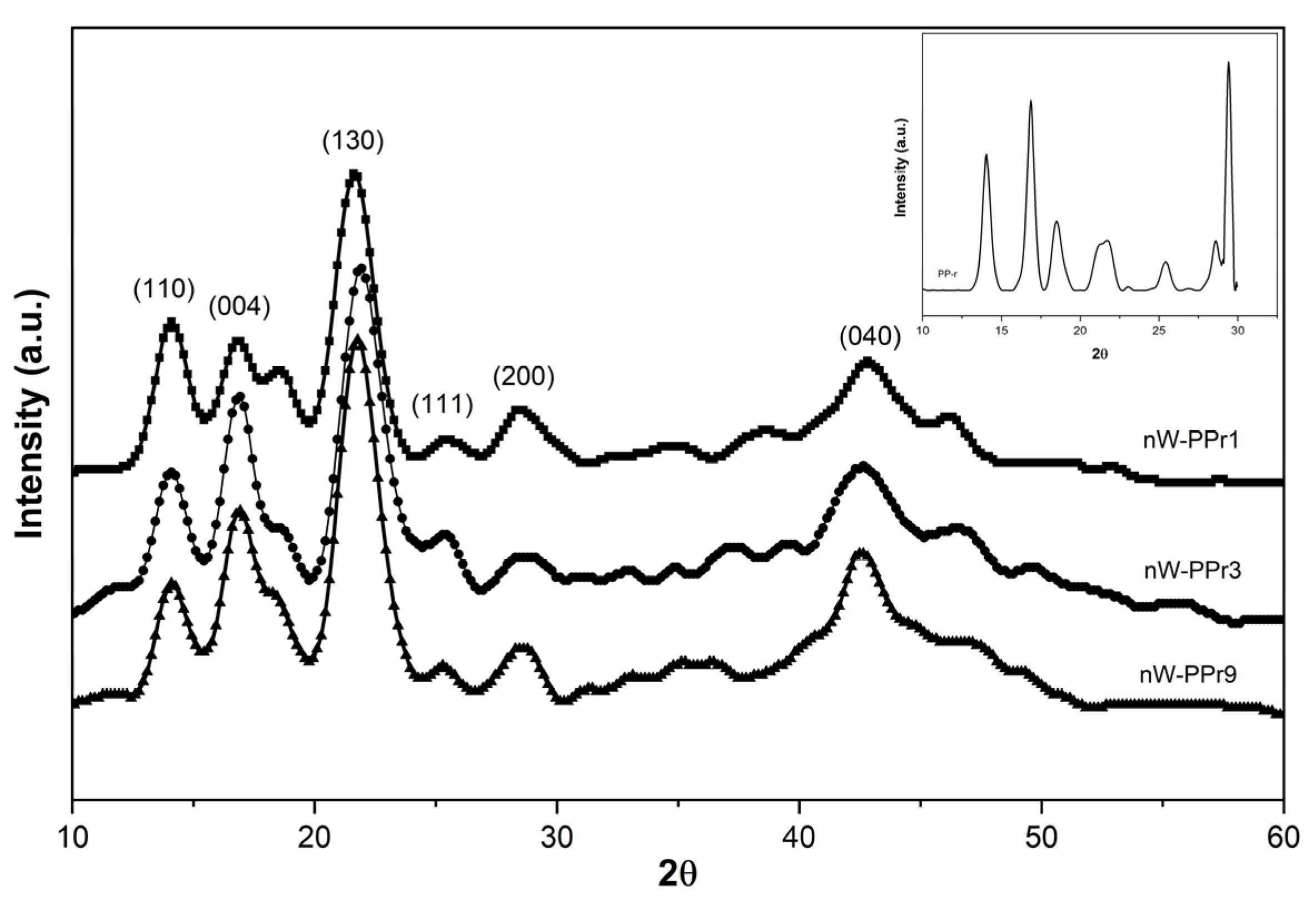
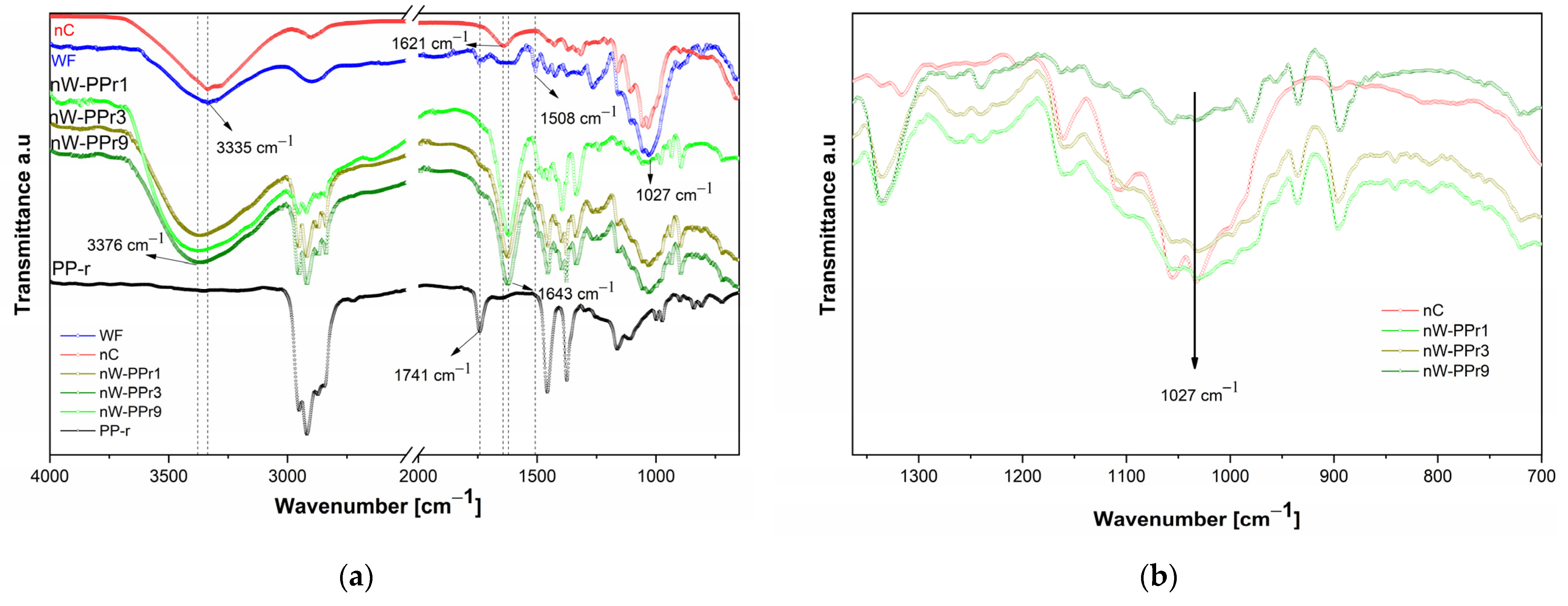
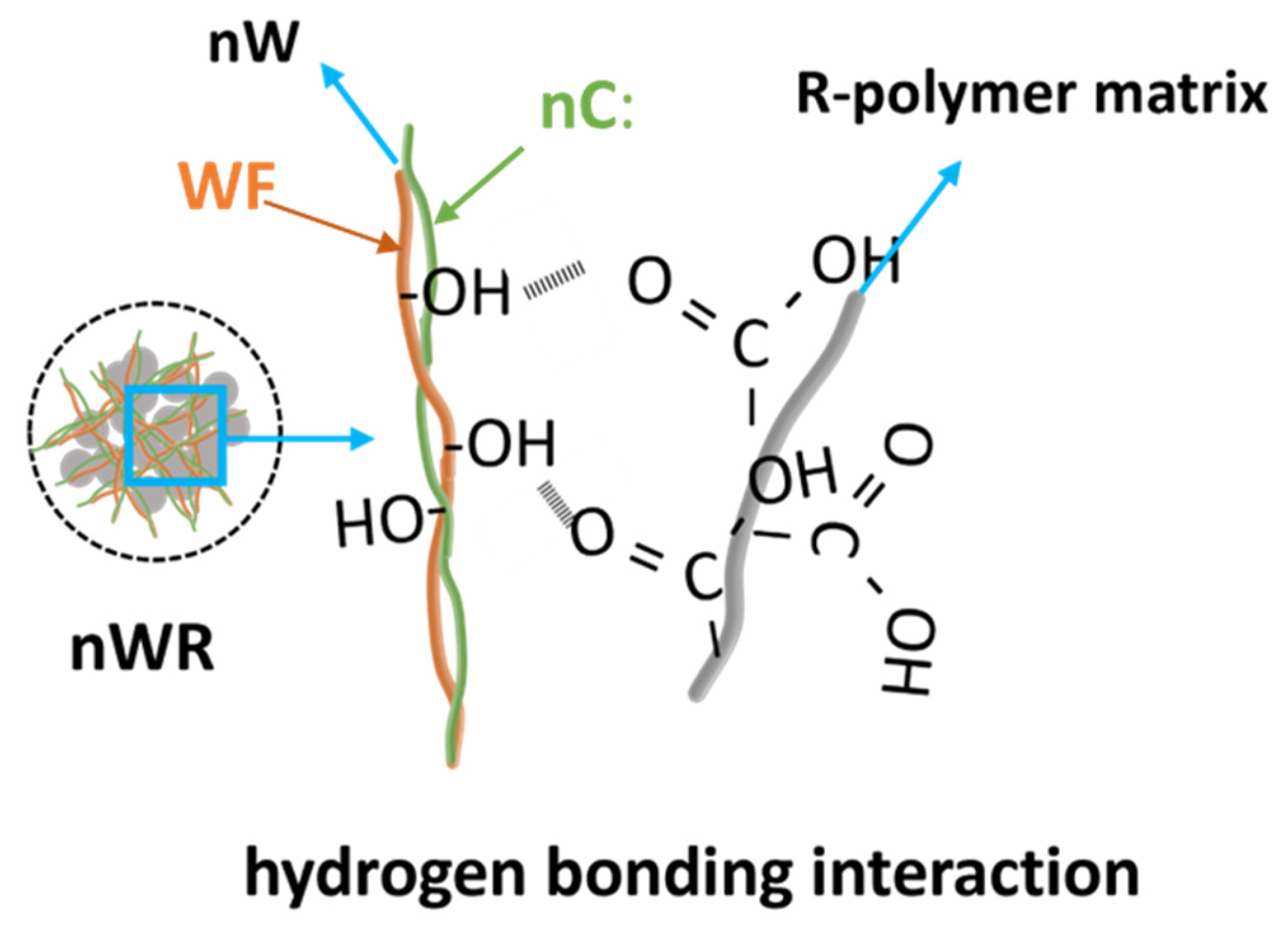
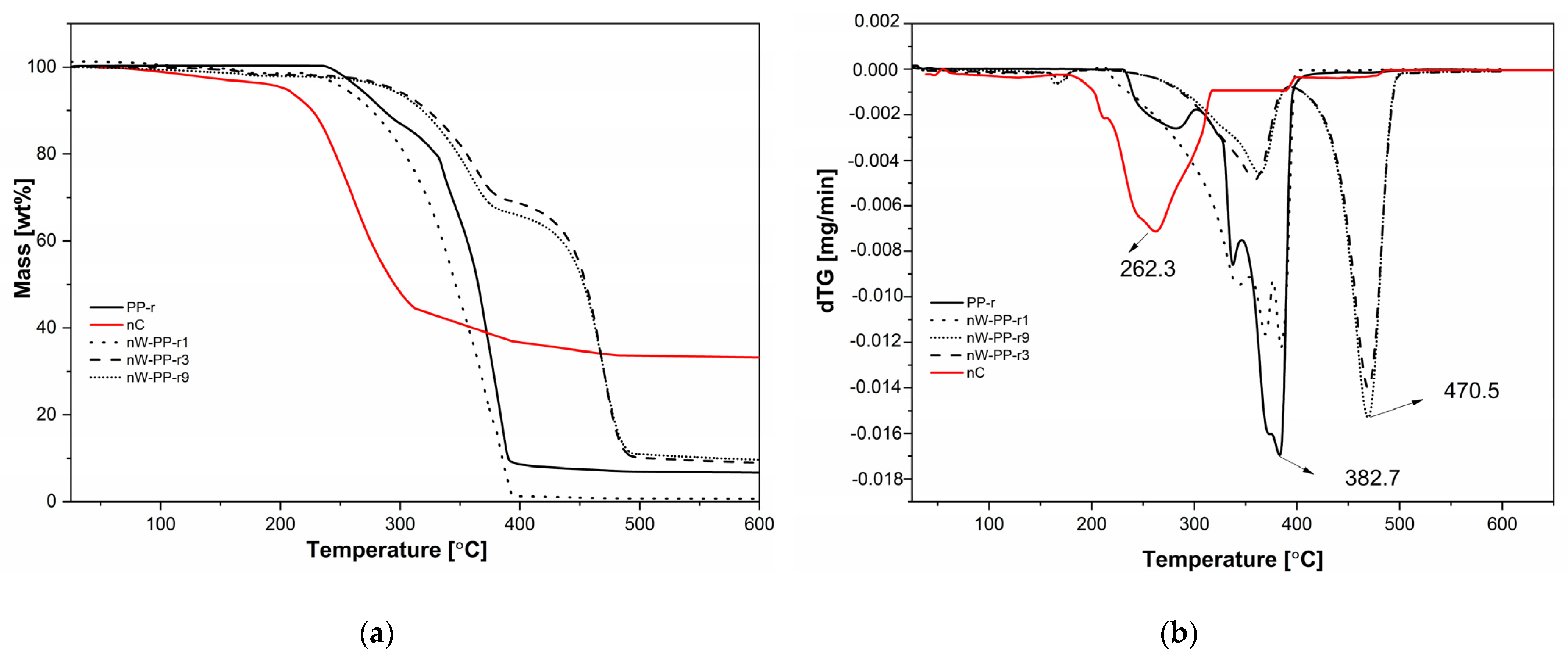
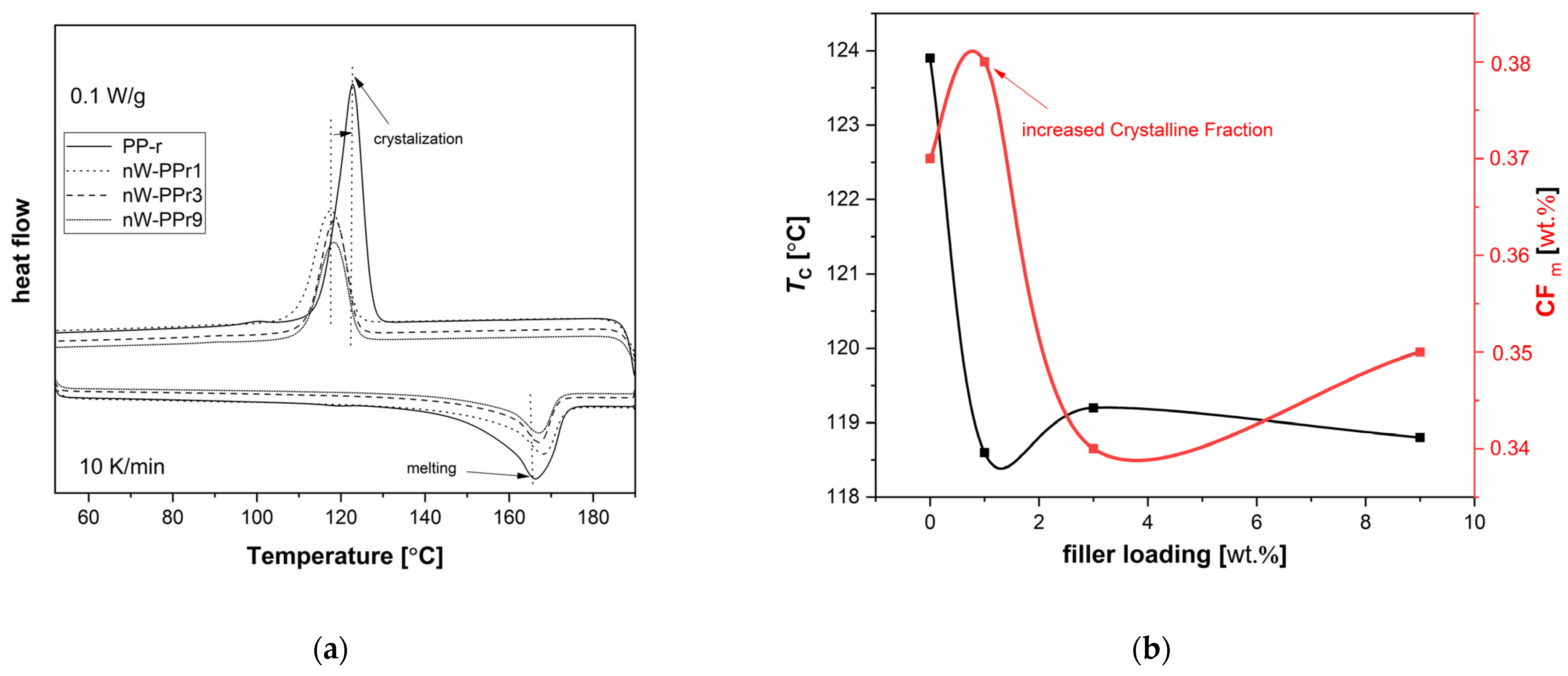
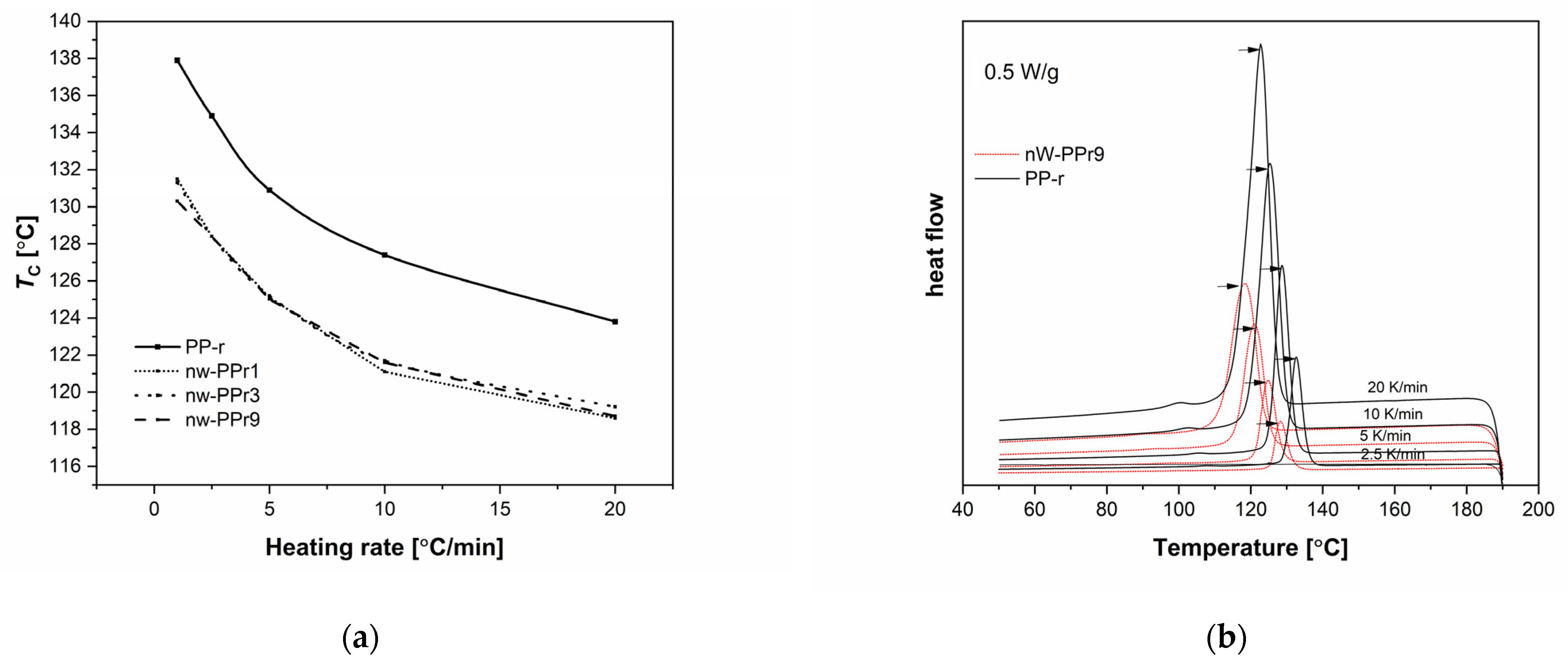


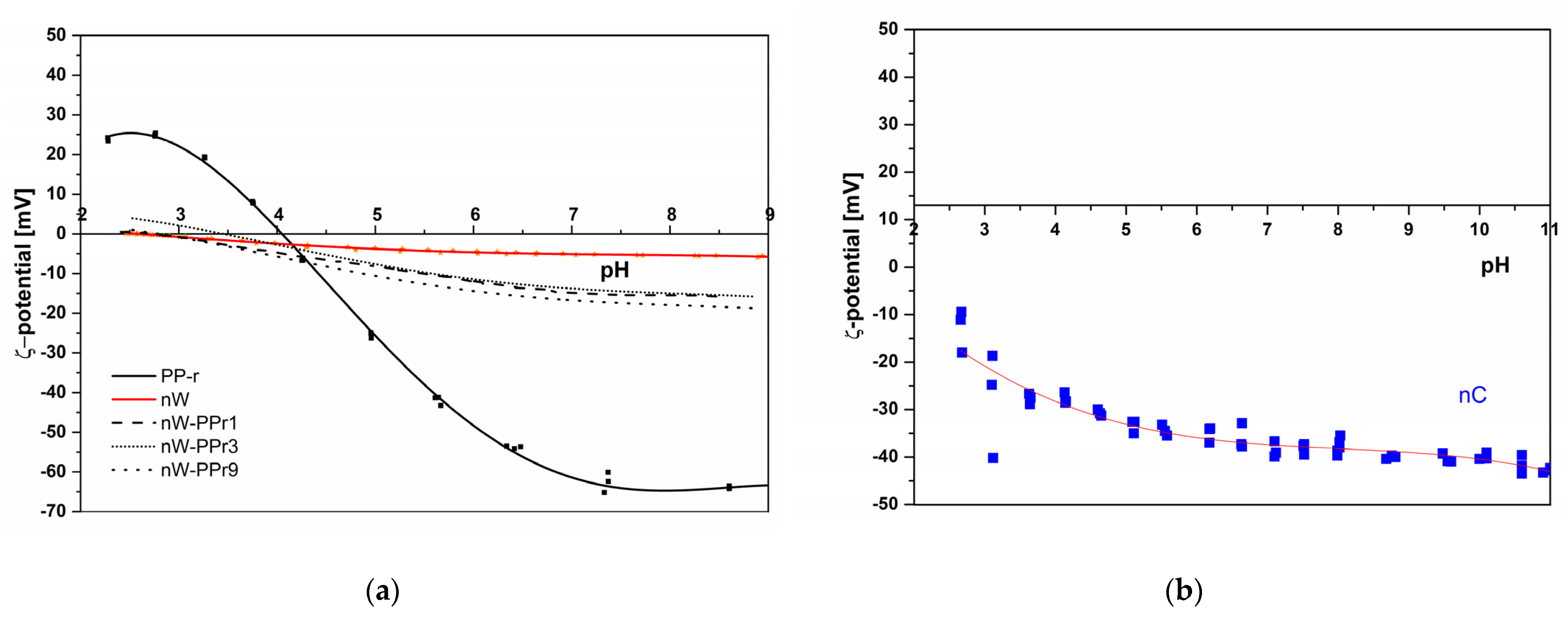
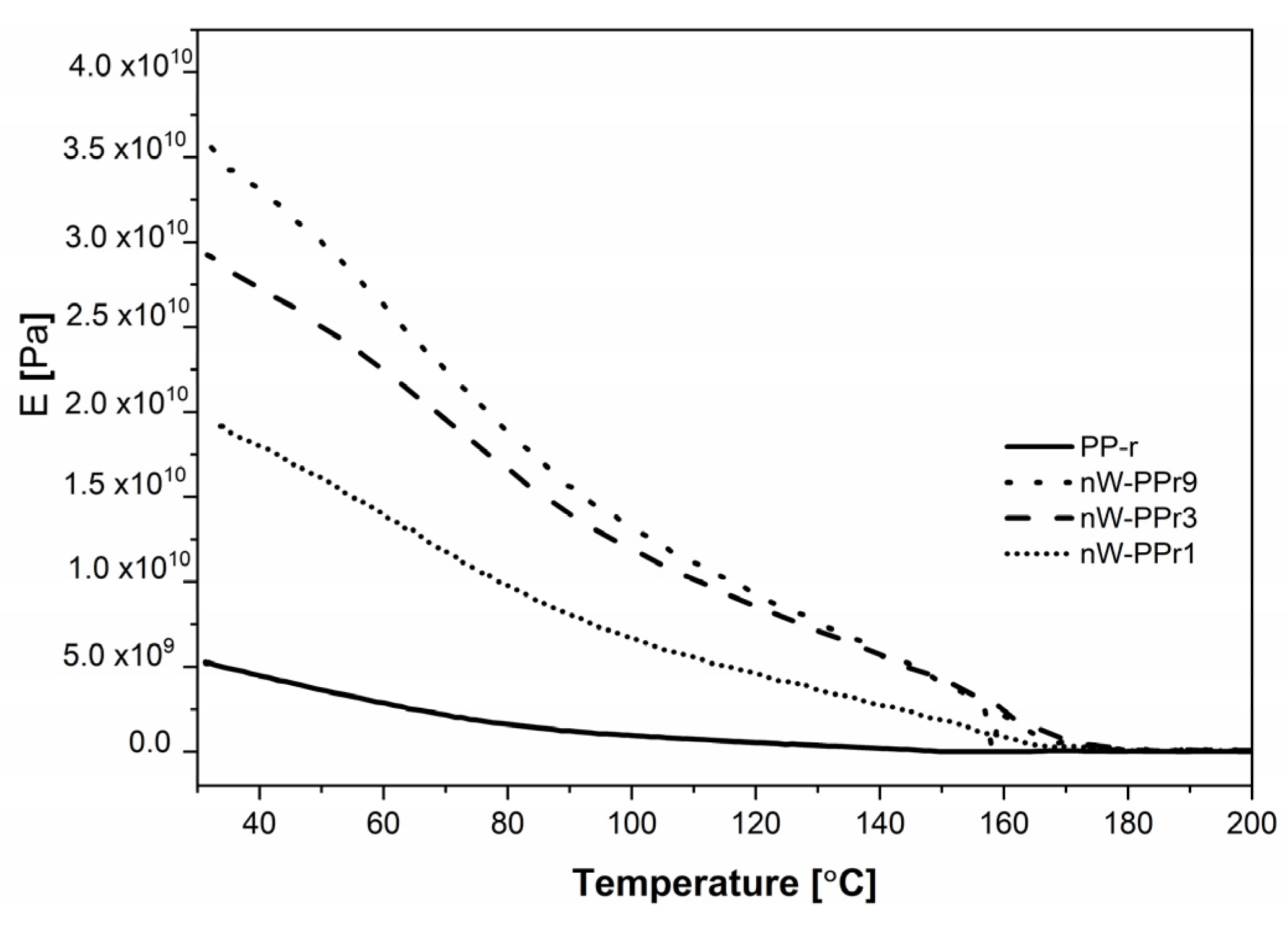
| Sample Description | Name of Sample |
|---|---|
| Recycled polypropylene | PP-r |
| PP-r + 50%WF + 1.0 wt% nC | nW-PPr1 |
| PP-r + 50%WF + 3.0 wt% nC | nW-PPr3 |
| PP-r + 50%WF + 9.0 wt% nC | nW-PPr9 |
| Sample | Tc (°C) | ΔHC (J/g) | Tm (°C) | χ (wt%) |
|---|---|---|---|---|
| PP-r | 123.9 | 80.63 | 166.8 | 37.9 |
| + 50%WF+ 1.0 wt% nC | 118.6 | 44.7 | 167.7 | 40.1 |
| + 50%WF+ 3.0 wt% nC | 119.2 | 36.1 | 166.6 | 34.7 |
| + 50%WF+ 9.0 wt% nC | 118.8 | 31.6 | 166.7 | 35.6 |
Disclaimer/Publisher’s Note: The statements, opinions and data contained in all publications are solely those of the individual author(s) and contributor(s) and not of MDPI and/or the editor(s). MDPI and/or the editor(s) disclaim responsibility for any injury to people or property resulting from any ideas, methods, instructions or products referred to in the content. |
© 2024 by the authors. Licensee MDPI, Basel, Switzerland. This article is an open access article distributed under the terms and conditions of the Creative Commons Attribution (CC BY) license (https://creativecommons.org/licenses/by/4.0/).
Share and Cite
Črešnar, K.P.; Plohl, O.; Zemljič, L.F. Functionalised Fibres as a Coupling Reinforcement Agent in Recycled Polymer Composites. Materials 2024, 17, 2739. https://doi.org/10.3390/ma17112739
Črešnar KP, Plohl O, Zemljič LF. Functionalised Fibres as a Coupling Reinforcement Agent in Recycled Polymer Composites. Materials. 2024; 17(11):2739. https://doi.org/10.3390/ma17112739
Chicago/Turabian StyleČrešnar, Klementina Pušnik, Olivija Plohl, and Lidija Fras Zemljič. 2024. "Functionalised Fibres as a Coupling Reinforcement Agent in Recycled Polymer Composites" Materials 17, no. 11: 2739. https://doi.org/10.3390/ma17112739
APA StyleČrešnar, K. P., Plohl, O., & Zemljič, L. F. (2024). Functionalised Fibres as a Coupling Reinforcement Agent in Recycled Polymer Composites. Materials, 17(11), 2739. https://doi.org/10.3390/ma17112739







